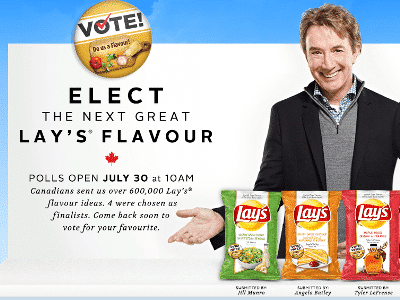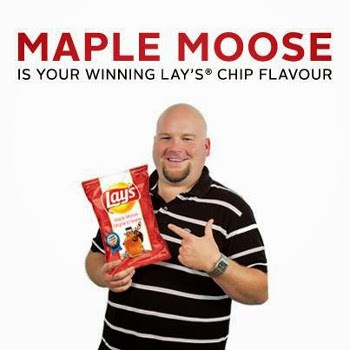

Just over a year ago, Frito-Lay, maker of Lay’s brand potato chips, wrapped up its American “Do Us A Flavor” campaign, in which chip flavours suggested by consumers battled it out in a kind of Thunder Dome-style, Facebook-centric reality competition. Actress Eva Longoria participated in the reveal, which conferred victory on Karen Weber-Mendham’s “Cheesy Garlic Bread” concept, which had its origin in the “tradition” of watching her children fight over garlic bread appetizers during their restaurant outings.
Weber-Mendham received a $1 million prize (or one percent of her flavour’s 2013 net sales, whichever is higher).
Longoria summed up the atmosphere in the aftermath of Frito-Lay’s competition. “We had so much fun celebrating the three ‘Do Us A Flavor’ finalists last night – it was a true Hollywood affair. While I believe all three finalists walked away winners, I am so thrilled for Karen. For those that haven’t had a chance to try Lay’s Cheesy Garlic Bread, you’re in for a treat.”
Weber-Mendham’s “Cheesy Garlic Bread” beat out the possibly more deserving “Chicken & Waffles” and “Sriracha” flavours. All the same, those runners-up took away $50,000 apiece.
While many were puzzled over the result, “Cheesy Garlic Bread’s” victory likely had less to do with each flavour’s individual merit as it did the public attitude towards Weber-Mendham’s folksy domestic narrative.
The Canadian version of the Frito-Lay competition was less straightforwardly celebratory and homespun. Renamed “Do Us A Flavour”, the controversial winner was “Maple Moose”, the brainchild of Tyler LeFrense, from Isle aux Morts (French for “Island of the Dead”), in Newfoundland. First prize in the Canadian competition was $50,000, plus 1% of net sales.
LeFrense was overwhelmed by the negative reaction to his roadkill-inspired flavour combination. “I am all for supporting a fellow newfie but I am sorry, those chips were awful,” tweeted Amy Langdon. Rachel West egged on the Twitter storm with, “You people are gross.” Nick Greeley added, “Everyone that I know would rather eat garbage than to have it again.” And Jordan Reid tweeted, “What the jesus is wrong with everyone?”
Maple Moose is the Lay's potato chip flavour winner? You people are gross.
— Rachel West (@rachel_is_here) October 22, 2013

“Social media can be a bad thing when you do something like this,” said LeFrense before philosophically concluding, “the rants and raves people have had against it, but it turned out in my favour.”
Frito-Lay discontinued “Maple Moose” in February, citing poor sales. LeFrense remained upbeat, despite his flavour’s defeat at the cash register. “It was definitely one of those once in a lifetime experiences. There is nothing I have done in my life so far that can compare to this past year,” he said.
Not exactly “a true Hollywood affair”, but what do you expect for 50 grand?
Nevertheless, the Canadian “Do Us A Flavour” competition is up and running again this year, with Bacon Poutine duking it out against Cinnamon Bun, Jalapeño Mac N’ Cheese and Tzatziki flavours.
It’s not as if Canadians have suffered a lack of adventurous chip flavours. Old Dutch, for example, without conducting any kind of competition, sells a Calamari and Tzatziki flavour under its Double Dutch specialty moniker.
And in the late 1970s, Hostess, in a desperate bid to stay relevant before being acquired by Frito-Lay, revealed their Cherry, Orange and Grape flavoured potato chips, which may have made sense at the time.
This year, too, the U.K. chip manufacturer Walkers has narrowed its competitive field down to six finalists: Pulled Pork in Sticky BBQ Sauce, Ranch Raccoon, Hot Dog with Tomato Ketchup, Sizzling Steak Fajita, Chip Shop Chicken Curry and Cheesy Beans on Toast.
Walkers actually originated the idea of crowd-sourced competitive chip flavour development back in 2008, with the involvement of celebrity chef Heston Blumenthal. The “Builder’s Breakfast” flavour took first prize in that inaugural competition. Charlie Brooker, writer of the brilliant “Black Mirror” TV series, reviewed several of the competing flavours, describing “Builder’s Breakfast” as the “taste of stale fried egg”, while rival “Chilli and Chocolate” reminded him of “excreted battery acid”, with “Cajun Squirrel” tasting to him “precisely like a tiny cat piping hot farts through a pot-pourri pouch into your mouth.”
Sweden’s Mysmatchen OLW chip brand held a similar competition, with “Kebab Dream” coming out on top, while the Swiss were offered the chance to combine 100 flavours in a web application, and then to vote on the results, with a panel making the final selections. The “Sunny Forest” flavour and a pickled cucumber and dill combination called Malaknesa tied for top prizes there, with the winners receiving a percentage of sales.
On the face of it, the “Do Us A Flavor/Flavour” campaign is an exercise in crowd-sourcing and user engagement. These campaigns are not the result of sagging brands or poor sales in this new, merciless world of the internet. The chip industry is relatively safe from digital disruption.
The point of these competitions is not to produce a chip that will sell more than BBQ or Salt and Vinegar, flavours whose flagship status is quite safe. The end game is for brands like Frito-Lay to engage the public, which means collecting and interpreting data via social media each time you register to complain against or praise a particular flavour.
The difference between the Watsons campaign, which was probably concocted with no greater end game in mind than creating a publicity splash and getting a little play in the media, and the Frito-Lay campaign is that while the first was outward looking, the second draws people in. It engages them.
These campaigns are not the result of sagging brands or poor sales in this new, merciless world of the internet. The chip industry is relatively safe from digital disruption.
In the Watsons campaign, the potato chip is the product. In the Frito-Lay campaign, data relating to your online behaviour is the product. Whether or not you think this is a bad thing depends on which of two camps you fall into.
Camp #1 thinks, “Hey, this is fun. New potato chip flavours. And I get to have my say on Facebook.”
Camp #2 reacts the way Charlton Heston’s character did at the end of Soylent Green when he tries to warn others that “Soylent Green is made out of people!” It’s a bit like the old joke about the Soviet Union. “In Russia, you don’t eat potato chip. Potato chip eat you.”
How did we make that shift, from the object of marketing being mainly about selling things to a form of data gathering in which both user data and the objects on sale become products?
You could argue that it was always this way, with astute marketers keeping an eye on consumer behaviour for the purpose of leveraging the underlying psychology behind purchasing decisions.
But things have changed significantly in the few years between the Watsons campaign in 2008 and the Frito-Lay/Facebook effort. It’s a hinge moment between one era, during which we had, in the words of economist Paul Krugman, “vast amounts of theory applied to extremely small amounts of data” and the next, which is the beginning of Big Data, in which we have more data than we can store, much less interpret.
For Frito-Lay, it began innocuously enough, with the chip maker reacting to a market threat.
In 2010, Frito-Lay had a woman problem. Smaller chip brands featuring “all natural” and locally sourced ingredients were threatening market share. Women, who overwhelmingly buy groceries on behalf of their families, bought into the health-conscious underdogs. So Optimum Media Direction (OMD), the agency that manages communications strategy for PepsiCo, Frito-Lay’s parent company, stepped in.
In 2011, OMD rebranded Tostitos and SunChips, 60% of the Frito-Lay portfolio, as “all natural” products. Their strategy paid off.

Having solved the immediate brand threat problem, OMD’s group account director Kristen Colonna, decided to go further. “We needed consumers to do more than know. We needed them to believe,” she said to AdWeek. “And then we needed them to advocate on our behalf.”
Her team approached Zynga, the game developer behind FarmVille. That collaboration between OMD and Zynga led to the development of a Frito-Lay Facebook community, incorporating games, sweepstakes, webisodes, testimonials and, of course, “likes”. Frito-Lay set the Guinness World Record for the fastest-growing brand page within 24 hours, with 1.8 million “likes” in a single day.
From there, it was a short hop to “Do Us A Flavor”, with user suggested flavours attracting the praise and ire of an online community intensely engaged in a debate over which is the best flavour and who deserves to win.
Most marketers see the writing on the wall. We are no longer in the era when it was enough for consumers to simply know that a brand exists by saturating all available media channels and hoping for the best.
Brands that succeed in the era of Big Data and user engagement will figure out how to entice consumers to, in the words of Kristen Colonna, “believe” and “advocate on our behalf”.
Anyway, don’t get too stressed about which flavour to vote for in the “Do Us A Flavour” campaign. (It’s “Bacon Poutine”, obviously.)
Just make sure you save room for dessert with Tim Horton’s “Duelling Donuts” competition, in which Jason Priestley, Jann Arden, Anna Olson and Ben Mulroney help the donut chain pick a new flavour. Personally, I like the sound of “The Lumberjack”. You have until August 27 to register your vote.
Leave a Reply
You must be logged in to post a comment.




 Share
Share Tweet
Tweet Share
Share




Comment